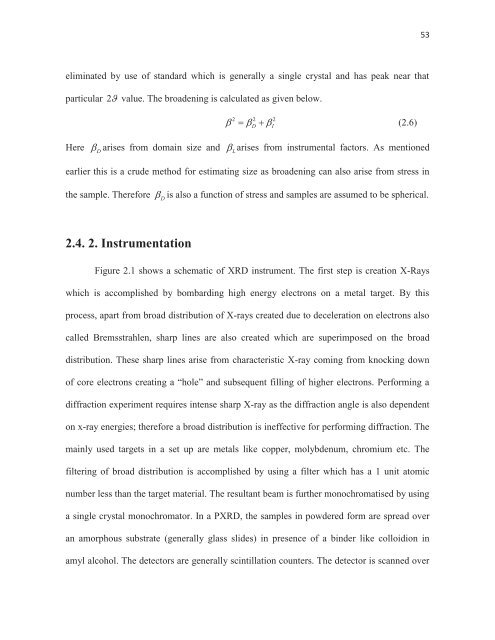CHEM01200604009 Sreejith Kaniyankandy - Homi Bhabha ...
CHEM01200604009 Sreejith Kaniyankandy - Homi Bhabha ...
CHEM01200604009 Sreejith Kaniyankandy - Homi Bhabha ...
You also want an ePaper? Increase the reach of your titles
YUMPU automatically turns print PDFs into web optimized ePapers that Google loves.
53<br />
eliminated by use of standard which is generally a single crystal and has peak near that<br />
particular 2 value. The broadening is calculated as given below.<br />
<br />
(2.6)<br />
2 2 2<br />
D I<br />
Here<br />
D<br />
arises from domain size and<br />
L<br />
arises from instrumental factors. As mentioned<br />
earlier this is a crude method for estimating size as broadening can also arise from stress in<br />
the sample. Therefore D<br />
is also a function of stress and samples are assumed to be spherical.<br />
2.4. 2. Instrumentation<br />
Figure 2.1 shows a schematic of XRD instrument. The first step is creation X-Rays<br />
which is accomplished by bombarding high energy electrons on a metal target. By this<br />
process, apart from broad distribution of X-rays created due to deceleration on electrons also<br />
called Bremsstrahlen, sharp lines are also created which are superimposed on the broad<br />
distribution. These sharp lines arise from characteristic X-ray coming from knocking down<br />
of core electrons creating a “hole” and subsequent filling of higher electrons. Performing a<br />
diffraction experiment requires intense sharp X-ray as the diffraction angle is also dependent<br />
on x-ray energies; therefore a broad distribution is ineffective for performing diffraction. The<br />
mainly used targets in a set up are metals like copper, molybdenum, chromium etc. The<br />
filtering of broad distribution is accomplished by using a filter which has a 1 unit atomic<br />
number less than the target material. The resultant beam is further monochromatised by using<br />
a single crystal monochromator. In a PXRD, the samples in powdered form are spread over<br />
an amorphous substrate (generally glass slides) in presence of a binder like colloidion in<br />
amyl alcohol. The detectors are generally scintillation counters. The detector is scanned over
















